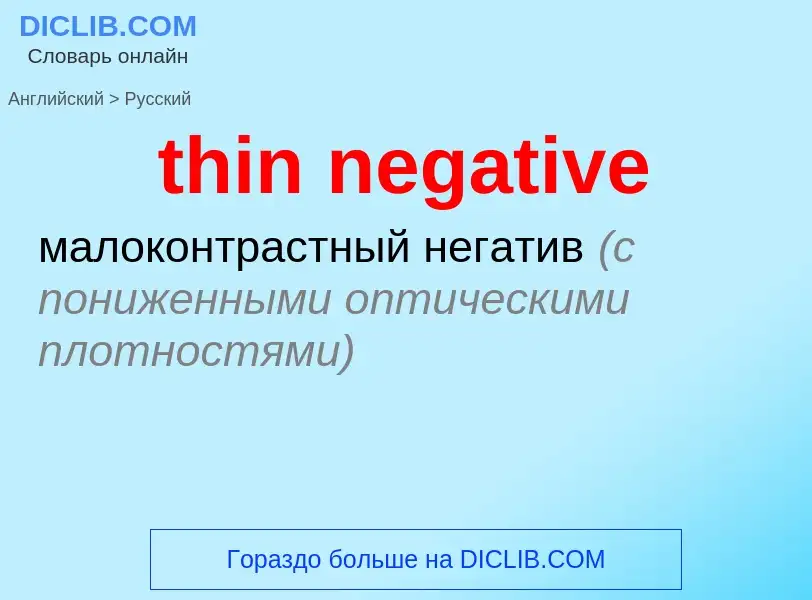Введите слово или словосочетание на любом языке 👆
Язык:
Перевод и анализ слов искусственным интеллектом ChatGPT
На этой странице Вы можете получить подробный анализ слова или словосочетания, произведенный с помощью лучшей на сегодняшний день технологии искусственного интеллекта:
- как употребляется слово
- частота употребления
- используется оно чаще в устной или письменной речи
- варианты перевода слова
- примеры употребления (несколько фраз с переводом)
- этимология
thin negative - перевод на русский
FINANCIAL CONCEPT
Thin capitalisation rules; Thin capitalization; Thin capitalization rules; Thin cap
thin negative
малоконтрастный негатив (с пониженными оптическими плотностями)
film negative
PHOTOGRAPHS IN WHICH THE TONES OR COLORS ARE REVERSED FROM THEIR APPEARANCE IN NATURE, USUALLY ON A TRANSPARENT SUPPORT OF CELLULOID, ACETATE, OR ON PAPER, INTENDED FOR THE PURPOSE OF PRODUCING POSITIVE PRINTS
Negative film; Photographic negative; Negative Film; Photo negative; Film negative; Negative (film); Film negatives; Negative image; Color negative; Inverted colors; Negative color
общая лексика
пленочный негатив
light client
LIGHTWEIGHT COMPUTER OPTIMIZED FOR CONNECTING TO A SERVER
Thin clients; Thin-client; Presentation client; Thin computing; Thin Computing; Thin Clients; Light client; Thin Client; Network computer; Winterm; Zero client; Ultra-thin client; Web thin client; Thinclient; ThinClient; Software Thin Client; List of protocols used by thin clients; Network terminal
Смотрите также
Определение
thin client
<networking> A simple client program or hardware device
which relies on most of the function of the system being in
the server.
Gopher clients, for example, are very thin; they are
stateless and are not required to know how to interpret and
display objects much more complex than menus and plain text.
Gopher servers, on the other hand, can search databases and
provide gateways to other services.
By the mid-1990s, the model of decentralised computing where
each user has his own full-featured and independent
microcomputer, seemed to have displaced a centralised model
in which multiple users use thin clients (e.g. {dumb
terminals}) to work on a shared minicomputer or mainframe
server. Networked personal computers typically operate as
"fat clients", often providing everything except some file
storage and printing locally.
By 1996, reintroduction of thin clients is being proposed,
especially for LAN-type environments (see the {cycle of
reincarnation}). The main expected benefit of this is ease of
maintenance: with fat clients, especially those suffering from
the poor networking support of Microsoft {operating
systems}, installing a new application for everyone is likely
to mean having to physically go to every user's workstation to
install the application, or having to modify client-side
configuration options; whereas with thin clients the
maintenance tasks are centralised on the server and so need
only be done once.
Also, by virtue of their simplicity, thin clients generally
have fewer hardware demands, and are less open to being
screwed up by ambitious lusers.
Never one to miss a bandwagon, Microsoft bought up {Insignia
Solutions, Inc.}'s "NTRIGUE" Windows remote-access product
and combined it with Windows NT version 4 to allow thin
clients (either hardware or software) to communicate with
applications running under on a server machine under {Windows
Terminal Server} in the same way as X had done for Unix
decades before.
(1999-02-01)
Википедия
Thin capitalisation
A company is said to be thinly capitalised when the level of its debt is much greater than its equity capital, i.e. its gearing, or leverage, is very high. An entity's debt-to-equity funding is sometimes expressed as a ratio. For example, a gearing ratio of 1.5:1 means that for every $1 of equity the entity has $1.5 of debt.
A high gearing ratio can create problems for:
- creditors, which bear the solvency risk of the company, and
- revenue authorities, which are concerned about excessive interest claims.


![Picture showing a [[dust storm]] during the [[Dust Bowl]] period, [[Texas Panhandle]], TX Picture showing a [[dust storm]] during the [[Dust Bowl]] period, [[Texas Panhandle]], TX](https://commons.wikimedia.org/wiki/Special:FilePath/Dust bowl, Texas Panhandle, TX fsa.8b27276 edit.jpg?width=200)


